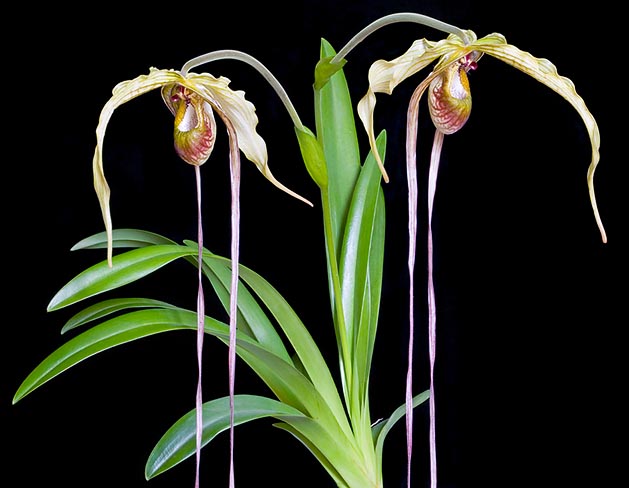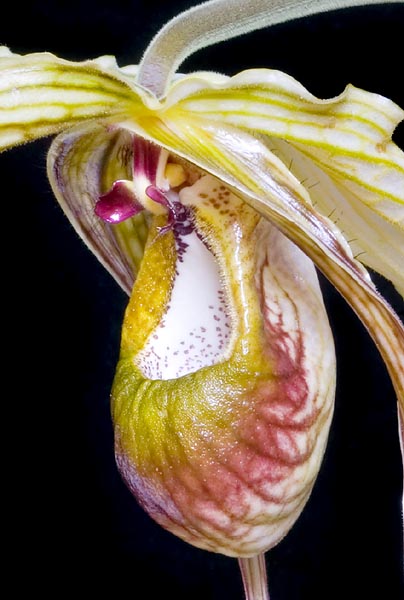Family : Orchidaceae

Text © Pietro Puccio

English translation by Mario Beltramini

With its 70 cm weblike petals, Phragmipedium caudatum did enchant many orchids lovers © Giuseppe Mazza
The name of the genus is the combination of the Greek terms “phragma” = division and “pédilon” = sandal, with reference to the ovary divided in three hollows (trilocular) and to the shape of the labellum; the Latin name of the species, “caudatum” = equipped with tail, refers to the long hanging petals.
Common names: mandarin orchid (English).
The Phragmipedium caudatum (Lindl.) Rolfe (1896) is an epiphytic or lithophytic herbaceous species, caespitose, with short stem wholly hidden by the imbricate foliar bases and 5-7 linear leaves, coriaceous, alternate, distichous, 15-50 cm long and 4-5 cm broad.
Floral terminal scape long up to 60 cm, pubescent, carrying 2-4 long-lasting flowers, two months about, which do open almost at the same time, with greenish-white sepals with dark green venations, pale green petals with pinkish margins and terminal part, white labellum shaded of pink towards the apex with green venations.
Dorsal, lanceolate, sepal, pointed, with wavy margins, 10-15 cm long and 1,5-2,5 cm broad, bent forward, lateral sepals united for their whole length to form, behind the labellum, as one only sepal (synsepalous) oblong-lanceolate, up to about 12 cm long and 2,5-4,5 cm broad, band-shaped petals, up to about 70 cm long and 0,5-1 cm broad, twined, and trilobed labellum, 4-6 cm long and about 3 cm broad, with median saccate lobe.
It reproduces by seed, in vitro, and by division, with each section provided with at least 3-4 tufts.

Close-up of the circa 2 months lasting flower © Giuseppe Mazza
Waterings must be regular and abundant during the vegetative period, leaving to dry up slightly before giving water again, preferably in the first hours of the day, in way to allow the water to dry up, thus avoiding stagnations at the axil of the leaves, in particular of the emerging vegetation, which may generate rottenness. In winter, the waterings are to be reduced, but without ever leaving the substratum to dry up completely and the luminosity is to be increased, even direct sun in the first hours of the day.
The waterings and the nebulisations are to be done with rain water, or water obtained from reverse osmosis or demineralised, and the fertilizations, during the vegetative period, with hydro-soluble balanced products, with microelements, at ¼ of the dosage, or less, of what suggested on the package, distributed and alternated in way to avoid salts accumulation at the roots, as the species is particularly sensitive to these. The substratum of cultivation can be formed by finely sliced bark fragments and by charcoal, with possible addition of sphagnum and agri-perlite; divisions and repottings are to be done by the end of the flowering, at the moment when the new vegetation does appear.
The species is inscribed into the appendix I of the CITES (endangered species whose trade is allowed only in exceptional circumstances).
Synonyms: Cypripedium caudatum Lindl. (1840); Cypripedium warszewiczianum Rchb.f. (1852); Selenipedium caudatum (Lindl.) Rchb.f. & Warsz. (1854); Selenipedium warszewiczianum (Rchb.f.) Rchb.f. & Warsz. (1854); Paphiopedilum caudatum (Lindl.) Pfitzer (1888); Paphiopedilum warszewiczianum (Rchb.f.) Pfitzer (1894); Phragmopedilum caudatum (Lindl.) Pfitzer (1903); Phragmopedilum warszewiczianum (Rchb. f.) Schltr. (1922); Phragmipedium warszewiczianum (Rchb. f.) Garay (1979).
→ For general notions about ORCHIDACEAE please click here.
